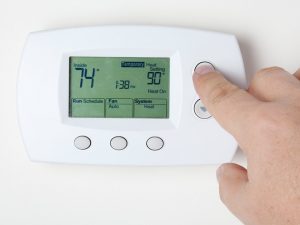During winter, people rely more heavily on their heating systems to keep their homes warm and comfortable. Two terms often surface on the thermostat for those using heat pumps – “auxiliary heat” and “emergency heat.” While both functions are crucial for providing warmth during cold spells, they operate under different conditions and serve distinct purposes. One of the area’s most trusted heating and air conditioner maintenance companies shares more information about them in this post.

Auxiliary Heat
Auxiliary heat, commonly called “aux heat” on thermostats, is integrated into heat pump systems. It is automatically activated when the heat pump alone cannot efficiently heat your home due to extremely cold outdoor temperatures. In such cases, the system calls upon a secondary heat source—typically electric heating coils—to provide the additional warmth needed to reach the set temperature indoors.
Think of auxiliary heat as a helper to your primary heat pump. It aids in maintaining efficiency and comfort by compensating for the heat pump’s diminished capacity to extract heat from frigid outdoor air. This is especially pertinent in areas where winter temperatures can plummet, making it more challenging for a heat pump to function optimally.
Emergency Heat
On the other hand, emergency heat is a manual setting on your thermostat that should be used only when the heat pump cannot provide heating due to a malfunction or during exceptionally cold weather, typically below 30 degrees. Emergency heat bypasses the heat pump completely, relying instead on the secondary heating system to warm your home.
It is important to note that while emergency heat can provide immediate relief in a pinch, it is generally less energy-efficient and more costly to operate over time. Therefore, this setting should be reserved for emergencies, such as when awaiting professional repair services for your unit.
When to Use Auxiliary and Emergency Heat
According to HVAC installation companies, auxiliary heat will engage automatically as needed, ensuring your home remains comfortable without any intervention. There’s no need to switch to auxiliary heat manually; your system will determine when it is necessary.
Conversely, emergency heat is an option you need to manually select. It must only be turned on when the primary heat pump is not functioning correctly or when extremely low temperatures render it ineffective. It is a stop-gap solution to ensure warmth until your system can be repaired or until outdoor conditions improve.
Maintenance and Efficiency Tips
Regular maintenance of your heat pump is vital in preventing situations where you need to resort to emergency heat. Regular inspections and tune-ups can help catch potential issues before they escalate into costly repairs. Additionally, understanding how to use your thermostat settings efficiently can avoid unnecessary energy consumption and high utility bills.
Cafco Services can assist with your HVAC repair, replacement, and maintenance needs. Reach us at (513) 242-3400 or through our contact form to schedule an appointment.
